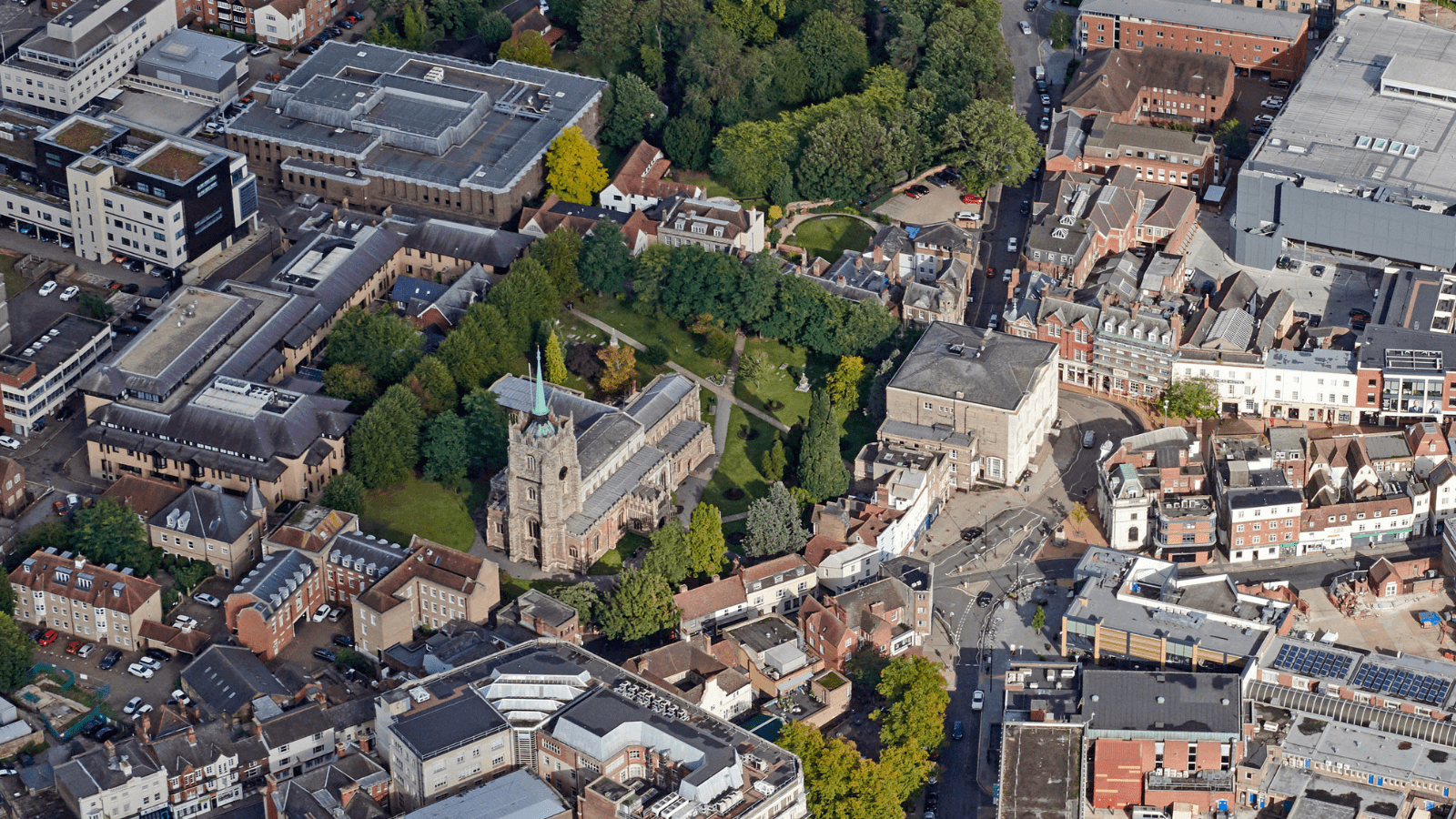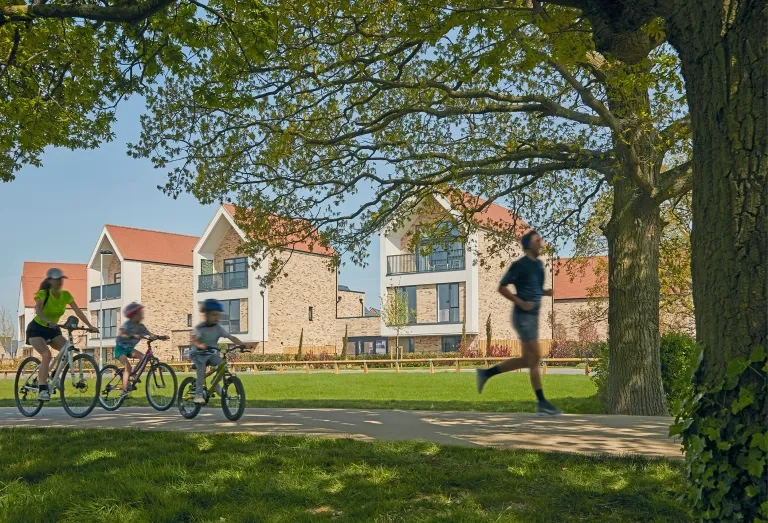Planning talking points: planning beyond homes — the big picture

What image does ‘planning’ conjure up for you? Most people think of homes: houses, flats and maisonettes being built for the growing population. You might think about the national housing crisis and how difficult it is to afford a home in the UK right now, or about where is and isn’t appropriate for new homes to go.
However, planning isn’t all about homes. The Local Plan, which guides where and what development can happen in Chelmsford, includes much more. Let’s take a birds-eye view of what else this important document includes.
New homes need to fit into a community
‘Infrastructure’ is a word often mentioned when talking about planning applications and new developments. People question, rightly, whether adding more homes to an area will put strain on transport, health services, shops and all the other things communities need. After all, more homes mean more people using all those services, and a decent home where you can access everything you need is the foundation of a decent life.
When a community grows, it’s essential to think beyond the homes themselves. The Local Plan and other planning documents meticulously outline not only where houses and flats can be built, but also the accompanying infrastructure needed to support the population. This includes everything from schools, parks and retail to cycle paths, roads and public transport. New homes shouldn’t overburden the existing community, and new residents must be able to live well too.
Councillors and staff consider not only what infrastructure is required, but what other challenges there might be. Say a new facility is needed and agreed. Will there be a delay between people moving into new homes and this being ready? Questions like this are discussed when a planning application is submitted and the developer must provide answers, with evidence, before their proposal will be approved.
If a council doesn’t have a Local Plan, it becomes much more difficult to require developers to provide this infrastructure when they build. Part of the document’s purpose is to look after the wellbeing of both new and existing residents by making sure that essential services stay available, or even get better, when development happens.
Neighbourhoods are getting ready for the future
In the face of climate change, the movement towards sustainable living has never been more urgent. Together, transport and buildings account for nearly two-thirds of all carbon emissions. The government’s Future Homes Standard sets a target for all new homes to be net-zero-carbon-ready by 2025.
To meet the standard, we need a fundamental shift in how new homes are built, moving away from traditional gas boilers. A mixture of using greener energy and building in a way that means less of it is needed in the first place can greatly reduce the carbon footprint of a household. Think high-performance insulation, triple glazing, air source heat pumps, and solar panels.
You can see homes like this already. There are relatively new builds in Beaulieu and Chelmsford Garden Community which are net-zero-carbon. Living in a home with these features isn’t only better for our planet – it’s cheaper, so requiring new builds to have them benefits people both now and in the future.
Getting around shouldn’t cost the earth
Every community needs decent transport links. You need to be able to reliably get to work, school, medical appointments, coffee dates and everything else you leave your home for. To help stave off climate change, these journeys should be as low-emission as possible, and this can be done in a number of ways.
Firstly, by providing different options that are greener than cars. Research by Sustrans tells us that when people have easy rail and cycle routes, they don’t use cars as much. Having these choices means that if you can’t or don’t want to drive, you can still get around. Whether some people in a community use sustainable transport all of the time, or most people use it some of the time, the carbon footprint of the whole area is reduced.
Second, by making sure it’s easy and quick for people to get to the places they need to go. This makes sense on a personal level, too. If you need to visit a doctor or get your kid to school, you don’t want it to be a long trek, and shorter journeys cut emissions and travel costs. The preferred options Local Plan promotes ‘walkable neighbourhood’ principles. To reduce car dependency, the policies within the plan consider how close a new development would be to local services before allocating a site for building. Walkable neighbourhoods are new neighbourhoods and streets designed to include a mix of uses, green spaces and local services and facilities that support the new development, within easy walking or cycling distance of home, reducing the need to travel,
Tackling climate change means making our way of life more sustainable. We live in a free country, so how you do that as an individual person is up to you, but by providing as many different options as possible, your local infrastructure can help lower carbon emissions across a whole community.

Infrastructure is often funded by developers
Putting all this in place for communities costs money. Developers pay something called ‘section 106 contributions’, which go towards building more affordable homes onsite or providing infrastructure on the site being developed. They may also pay the ‘community infrastructure levy’, which pays for things that mitigate the effects of their development on the wider area.
From including more affordable homes in a development and funding new schools to putting play equipment in parks and building flood defences, these contributions are vital to the fabric of new communities. Also called ‘planning obligations’, they are only to be used for things that are needed and directly related to the development. The council can’t use them for anything else and they have to be spent within a set timeframe. The new bridge that connects the Boreham Interchange to Beaulieu, for example, was paid for through planning obligations, as well as upgrades to Chelmsford’s High Street.
While some services are in councils’ control, others are overseen by the government. For example, the city council’s responsibilities include bin collections, local planning, theatres and leisure centres, and housing. The county council’s services include social care, roads and paths, and libraries. Things like laws, healthcare, defence and the economy are down to the national government. All of these things affect daily life, so your local council, county council and government need to work together to meet the needs of Chelmsford’s growing population.
These planning obligations are proposed to be replaced by the government’s Infrastructure Levy, which serves the same purpose but works a little differently. The new levy would be phased in over ten years. You can read more about it on gov.uk.
Help the council get the Local Plan right
As Chelmsford evolves and changes, we need planning to consider the full needs of the community, not just housing. The Local Plan not only allocates possible space for new homes, but also lays the foundation for sustainable, healthy, thriving neighbourhoods. As residents move into their new homes, the necessary infrastructure needs to be provided to serve them. Sometimes this is done in a phased manner rather than being provided ‘up front’.
By considering infrastructure needs, embracing energy efficiency and greener transport, and making sure all this is funded, we can build resilient communities that suit the needs of everyone who lives here.
Achieving this takes great care, which is why the Local Plan is regularly reviewed and why local residents and many public agencies are consulted to get it right. Chelmsford City Council is currently running a public consultation on the Local Plan and asks everyone who can to get involved. You can take part at: https://www.chelmsford.gov.uk/planning-and-building-control/planning-policy-and-local-plan/local-plan-review/




